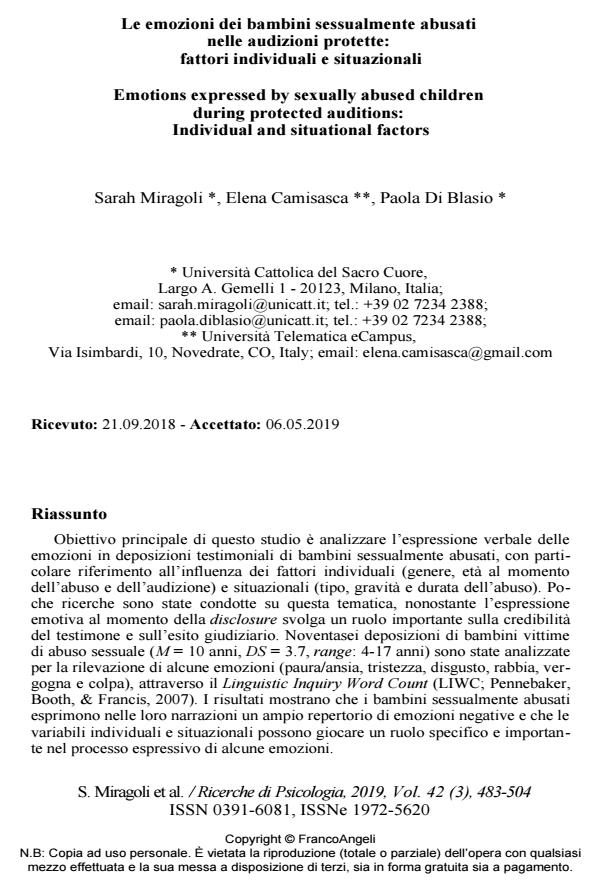Le emozioni dei bambini sessualmente abusati nelle audizioni protette: fattori individuali e situazionali
Titolo Rivista RICERCHE DI PSICOLOGIA
Autori/Curatori Sarah Miragoli, Elena Camisasca, Paola Di Blasio
Anno di pubblicazione 2019 Fascicolo 2019/3
Lingua Italiano Numero pagine 22 P. 483-504 Dimensione file 224 KB
DOI 10.3280/RIP2019-003003
Il DOI è il codice a barre della proprietà intellettuale: per saperne di più
clicca qui
Qui sotto puoi vedere in anteprima la prima pagina di questo articolo.
Se questo articolo ti interessa, lo puoi acquistare (e scaricare in formato pdf) seguendo le facili indicazioni per acquistare il download credit. Acquista Download Credits per scaricare questo Articolo in formato PDF

FrancoAngeli è membro della Publishers International Linking Association, Inc (PILA)associazione indipendente e non profit per facilitare (attraverso i servizi tecnologici implementati da CrossRef.org) l’accesso degli studiosi ai contenuti digitali nelle pubblicazioni professionali e scientifiche
Obiettivo principale di questo studio è analizzare l’espressione verbale delle emozioni in deposizioni testimoniali di bambini sessualmente abusati, con particolare riferimento all’influenza dei fattori individuali (genere, età al momento dell’abuso e dell’audizione) e situazionali (tipo, gravità e durata dell’abuso). Poche ricerche sono state condotte su questa tematica, nonostante l’espressione emotiva al momento della disclosure svolga un ruolo importante sulla credibilità del testimone e sull’esito giudiziario. Noventasei deposizioni di bambini vittime di abuso sessuale (M = 10 anni, DS = 3.7, range: 4-17 anni) sono state analizzate per la rilevazione di alcune emozioni (paura/ansia, tristezza, disgusto, rabbia, vergogna e colpa), attraverso il Linguistic Inquiry Word Count (LIWC; Pennebaker, Booth, & Francis, 2007). I risultati mostrano che i bambini sessualmente abusati esprimono nelle loro narrazioni un ampio repertorio di emozioni negative e che le variabili individuali e situazionali possono giocare un ruolo specifico e importante nel processo espressivo di alcune emozioni.
Parole chiave:Abuso sessuale infantile, emozioni, narrazione traumatica, analisi testuale.
- Coerenza narrativa e frequenza dell'evento traumatico: un'analisi su deposizioni di abuso sessuale infantile Vittoria Badino, in MALTRATTAMENTO E ABUSO ALL'INFANZIA 3/2021 pp.73
DOI: 10.3280/MAL2020-003007 - Coherence in Children’s Reports of Sexual Abuse: Age, PTSD, and Questioning Style Sarah Miragoli, Vittoria Badino, Elena Camisasca, in Journal of Forensic Psychology Research and Practice /2025 pp.772
DOI: 10.1080/24732850.2024.2364277 - Il ruolo attivo della vittima in caso di abuso sessuale: conseguenze in adolescenza Rachele Maria Valentini, in MALTRATTAMENTO E ABUSO ALL'INFANZIA 3/2023 pp.107
DOI: 10.3280/MAL2022-003006 - Dire l'indicibile. I presupposti necessari alle verifiche di attendibilità e credibilità nei casi di violenza sessuale infantile Laura De Rui, in MALTRATTAMENTO E ABUSO ALL'INFANZIA 1/2022 pp.53
DOI: 10.3280/MAL2022-001004 - An Examination of the Synergy of Age and PTSD on Narrative Coherence in Child Sexual Abuse Testimony Sarah Miragoli, Elena Camisasca, in Journal of Child Sexual Abuse /2022 pp.743
DOI: 10.1080/10538712.2022.2131669
Sarah Miragoli, Elena Camisasca, Paola Di Blasio, Le emozioni dei bambini sessualmente abusati nelle audizioni protette: fattori individuali e situazionali in "RICERCHE DI PSICOLOGIA " 3/2019, pp 483-504, DOI: 10.3280/RIP2019-003003